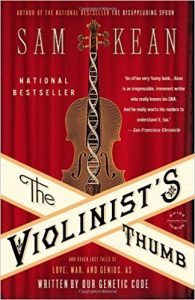 In The Violinist’s Thumb, Sam Kean takes us on a tour of how we have learned about the genes that define us and the implications of some of discoveries behind that science. I admit that biology is not my favorite branch of science, but Kean does an excellent job of telling an engaging story about the people, their world, and their discoveries that have led to our current understanding of how our genes impact everything from our behavior to our talents to our interactions with the rest of nature. For anyone with even a passing interest in our genes and DNA, what makes us tick biologically, and how we’ve learned what we learned, this is a great book.
In The Violinist’s Thumb, Sam Kean takes us on a tour of how we have learned about the genes that define us and the implications of some of discoveries behind that science. I admit that biology is not my favorite branch of science, but Kean does an excellent job of telling an engaging story about the people, their world, and their discoveries that have led to our current understanding of how our genes impact everything from our behavior to our talents to our interactions with the rest of nature. For anyone with even a passing interest in our genes and DNA, what makes us tick biologically, and how we’ve learned what we learned, this is a great book.
Kean’s focus is on DNA, the science that, over many years, led to our discovery and subsequent understanding of what DNA does, and the people behind that discovery. As he guides us through the history of DNA science, he also takes us on interesting detours, introducing us to non-scientists whose lives demonstrate the point he is trying to make. These are people with either less common genes or mutations that gave them some benefit, such as more flexible hands for playing, for example, a violin, but often also made them rather sickly and not long for the world.
There are simply too many interesting tidbits in this book to really give them justice. But, I highlight a few that particularly piqued my interest:
- Ultraviolet light can cause kinks in certain places in DNA. Nearly all animals and plants have enzymes that can fix these kinks. Mammals don’t. That is why mammals sunburn.
- Women were typically not admitted into the science club. One exception were Catholic nuns, who were unmarried and had the financial support and independence from the church-run convents to pursue science.
- Polar bears survive on eating seals. Seals have a high abundance of vitamin A, which allows them to survive in the cold, promoting growth of fat cells. Polar bears have adapted to this, and can tolerate high levels of vitamin A, which is stored in their liver. However, the concentrations of vitamin A in their liver is toxic to most all other animals, even other polar bears if they ate another polar bear liver: “As little as one ounce of polar bear liver can kill an adult human, and in a ghastly way.”
- Our DNA isn’t entirely “human” – about 8 percent is ancient virus DNA, that was introduced as viruses attacked our ancient ancestors.
- Toxoplasma gondil (Toxo) is a parasite that exists and thrives in the guts of cats. Rats who are infected with it are attracted to cat urine, making them easy prey for cats, and thus spreading the parasite to more cats. “Overall it infects one-third of people worldwide,” settling in our brains. There is evidence that it makes infected people less risk adverse: it can make dopamine and “Some emergency room doctors report that motorcycle crash victims often have unusually high numbers of Toxo cysts in their brains.“
- “Viruses probably created the mammalian placenta, the interface between mother and child that allows us to give birth to live young and enables us to nuture our young.”
- “Every known ethnic group worldwide has one of two genetic signatures that help our bodies fight off certain diseases that cannibals catch, especially mad-cow-like diseases that come from eating each other’s brains. This defensive DNA almost certainly wouldn’t have become fixed worldwide if it hadn’t once been all too necessary.”
- Trauma we experience can be passed down to our children and, even more amazingly, to their children. Women with PTSD from the 9/11 attacks who had kids, particularly those who were in their third trimester at the time, have kids with higher levels of anxiety and acute distress than others in some situations.
- Possibly the most amazing fact is that a child’s health is more directly related to the father’s diet during his so-called slow growth period, about 9-12 years old: “Even more strangely, the child got a health boost only if the father faced starvation. If the father gorged himself, his children lived shorter lives with more diseases.“